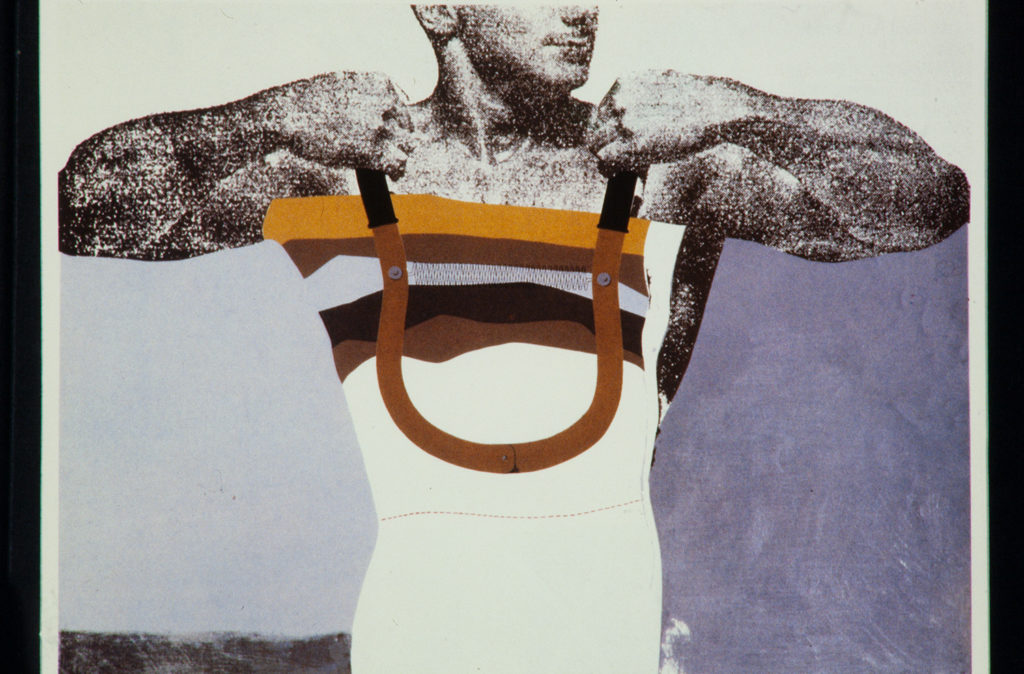ORGANISER New Zealand Art Gallery Directors Council SPONSOR Blueport ACT (NZ) Limited, British Council, Van der Roer Design Group OTHER VENUES Manawatu Art Gallery, Palmerston North 5 May-19 June 1988, Dunedin Public Art Gallery 25 August - 2 October, McDougall Art Gallery, Christchurch 14 October - 13 November, Suter Art Gallery, Nelson 23 November - 11 December, Auckland Art Gallery 22 December - 29 January 1989, Sarjeant Gallery. Wanganui 7 February - 19 March 1989, Waikato Museum of Art and History, Hamilton 29 March - 7 May 1989
How many major works of art have appeared in the twentieth century in which an automobile figures at all? How many feature vacuum cleaners?—Richard Hamilton
The British pop-art pioneer, Richard Hamilton, was a prolific printmaker, producing much of his key work in print media. This show is a comprehensive survey of his printmaking work. With 143 works, spanning five decades, it includes all but fifteen of his prints. As a printmaker, Hamilton was technically experimental. The show features works using etching, screen-printing, lithography, offset printing, collotype, and photogravure.
The show starts with Hamilton's early drypoint studies of the human body (1939), his abstracted images of machinery in the Reaper series (1949) and his plant-and-lifeform inspired Microcosmos series (1950).
Hamilton switches gear in 1955, when the watershed show This Is Tomorrow opens at London’s Whitechapel Gallery. Its catalogue includes his iconic collage, Just What Is It that Makes Today's Homes So Different, So Appealing? It depicts a pin-up muscleman and a pin-up girl in a jazzy modern interior, stuffed with appliances. Hamilton's 'muscle Mary’ holds a lollipop bearing the word ‘pop’. A year after the Whitechapel show, Hamilton explains, 'Pop art should be popular, transient, expendable, low-cost, mass-produced, young, witty, sexy, gimmicky, glamorous, and big business.’ His subjects will encompass the cinema, domestic appliances, modern architecture, advertising, cars, clothes, and movie and music idols.
But Hamilton is also an intellectual and a forerunner of conceptualism. His work combines an interest in transient pop culture with a highly intellectual approach to art making. He is a fan of—and, later, a close friend of—Marcel Duchamp. He reconstructs Duchamp's Large Glass in the mid-1960s, and organises the The Almost Complete Works of Marcel Duchamp show at London’s Tate Gallery in 1966.
The show includes many classic Hamiltons, including the series My Marilyn (1965), I'm Dreaming of a White Christmas series (1967), and Swingeing London (1968–9),
My Marilyn reproduces proof sheets from a photoshoot with Marilyn Monroe in 1962. Monroe would cross out shots she rejected for release. However, Hamilton's painterly cancellations can also be read as kisses. The inclusion of 'my' in the title points to Hamilton's own wife, who was killed in a car accident in 1962, the same year Monroe died.
I'm Dreaming of a White Christmas reproduces a film still of Bing Crosby in negative, transforming the crooner from a dour white man in a black hat to a black hipster with a white hat. Hamilton says he turned Crosby into 'his psychological opposite’.
Swingeing London is based on a newspaper photograph of the Rolling Stones frontman Mick Jagger and art dealer Robert Fraser handcuffed together after their famous arrest for drug possession. Fraser's London gallery was the centre of the Swinging London in the 1960s and many pop artists exhibited there, including Hamilton. The title puns on 'swinging London’ and the judge's 'swingeing' punishment ('swingeing' being slang for 'severe' or ‘drastic').
Hamilton likes the ubiquity and affordably of the print. His most ubiquitous work must be his sleeve design for the 1968 Beatles album, now known as The White Album. After Peter Blake’s psychedelic sleeve art for Sgt. Pepper’s Lonely Hearts Club Band, Hamilton went for a plain white sleeve embossed with the name of the band. The twist was to make this mass-produced object feel rare, which Hamilton did by mechanically numbering each cover. Hamilton also designed an insert poster—collaging photos of the band members.
The show is well received. In the Evening Post, Ian Wedde admits Hamilton is one of his cultural heroes. He writes, 'What you find is not a typical "Hamilton" but as Hamilton himself puts it in his introduction [to the catalogue], a “single mind at work” in multifarious stratagems and images.’ In National Business Review, Lita Barrie says, 'Using the impersonal nature of the print to undermine the hallowed notion of an original signature, Hamilton creates a space where the spectator can form their own reading.’ She calls the show ‘an exceptionally informative view of this British artist's philosophic credo’. Director John Leuthart says the exhibition is in line with the Gallery’s policy of showing ‘the works of artists concerned with the world and the issues surrounding us’.
A thirty-minute documentary on Hamilton plays during the show. The Gallery operates a print studio next door, where printmaking workshops are conducted during the show.



















































































